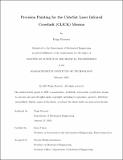Precision Pointing for the CubeSat Laser Infrared CrosslinK (CLICK) Mission
Author(s)
Forester, Paige
DownloadThesis PDF (9.885Mb)
Advisor
Cahoy, Kerri
Terms of use
Metadata
Show full item recordAbstract
Advances in Free Space Optical Communications have led to numerous missions that have demonstrated optical space-to-ground links, however, fewer missions have demonstrated optical space-to-space links. NASA’s CubeSat Laser Infrared CrosslinK (CLICK) Mission aims to be the first to demonstrate optical space-to-space communication on a CubeSat scale using Commercial Off the Shelf (COTS) components that include a micro electromechanical system (MEMS) fine steering mirror for precision pointing. The first phase of the CLICK mission, CLICK-A, launched in September 2022 to demonstrate optical downlink. The second phase, CLICK-B/C, aims to demonstrate optical crosslink between two spacecraft: CLICK-B and CLICK-C. Optical crosslink communication requires precision pointing for both spacecraft to close the link. The development of the CLICK-B/C Fine Pointing, Acquisition, and Tracking (PAT) is presented in this thesis, as well as the analysis of disturbance rejection and evaluation of expected spacecraft disturbances. This thesis also asses the slewing required for differential drag control which is used to maintain the crosslink range between the two CubeSats. Preliminary results are presented from the CLICK-B/C flight hardware integration and testing phases, as well as findings from simulation of the lasercom payload’s performance.
Date issued
2025-02Department
Massachusetts Institute of Technology. Department of Mechanical EngineeringPublisher
Massachusetts Institute of Technology